Author: 100y.eth, Four Pillars
Compiled by: Tim, PANews
Key Points Summary
On August 13, 2025, Circle officially launched its self-developed Arc public chain: a Layer 1 underlying network built specifically for the USDC stablecoin. In the context of a recent surge in stablecoin metrics, the release of Arc has attracted widespread attention, marking Circle's formal entry into the trend of issuing dedicated blockchains.
Arc aims to enable enterprises and institutions to seamlessly access blockchain infrastructure while complying with regulatory requirements, specifically through three core capabilities: 1) using USDC stablecoin as the Gas token; 2) providing high scalability and instant transaction confirmation based on the Malachite consensus algorithm; 3) supporting optional privacy features that users can enable.
Arc adopts an operational strategy that is both similar to and distinct from blockchain solutions centered around USDT (such as Stable and Plasma supported by Tether). Its main differentiated advantages are reflected in:
The emergence of Arc has a significant impact on the industry. This article delves into: 1) the different development directions of Tether and Circle in the stablecoin network field; 2) whether competition between Circle and Tether will intensify; 3) the dynamics of other networks such as Codex and 1Money Network; 4) whether Arc's true competitor will be Tempo rather than Stable or Plasma.
1. Circle Just Launched Arc
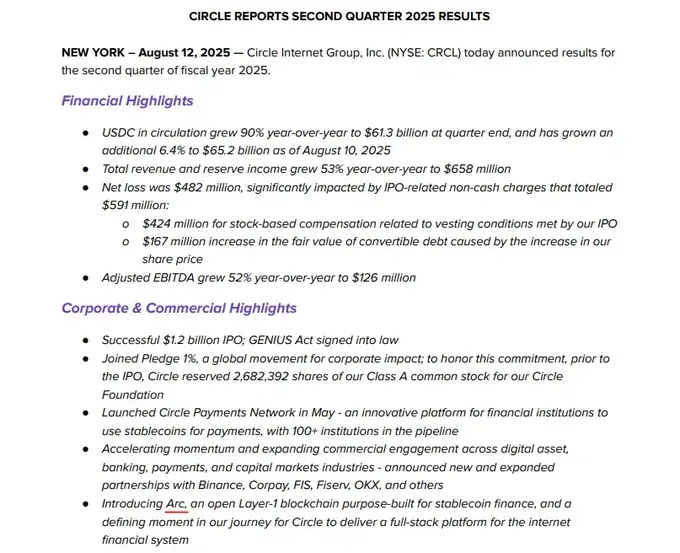
Source: Circle
On August 13, 2025, Circle announced the launch of its self-developed USDC-native L1 blockchain Arc in its Q2 financial report, simultaneously releasing a lightweight technical document. Notably, just a few hours earlier on the same day, the world's largest payment service provider Stripe also officially launched its L1 blockchain Tempo. The simultaneous release of dedicated blockchains by these two fintech giants makes August 13, 2025, an important milestone in industry development.
The high attention surrounding Arc launched by Circle is due to the fact that the stablecoin sector has recently become one of the hottest topics in the crypto community. Led by Tether's CEO and the stablecoin network projects Stable and Plasma invested by Bitfinex, several new L1 public chains, including Codex and 1Money Network, are being tailored for stablecoins. Against this backdrop, expectations within the crypto community for Circle's related initiatives have been rising, and now Circle has finally unveiled Arc.
So, is Arc, released by Circle today, just another Layer 1 network specifically serving USDC, indistinguishable from the various stablecoin networks that have emerged recently; or does it bring a distinctly different approach compared to other projects?
2. What is Arc?
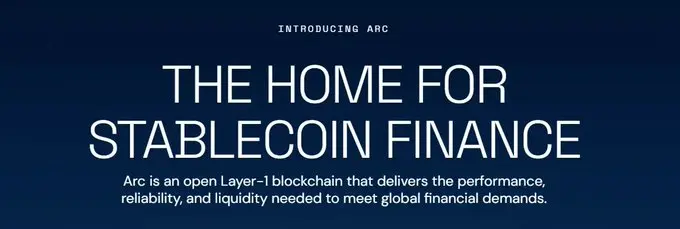
Source: Arc
2.1 USDC Dedicated Chain
Before exploring the similarities and differences between Arc and other stablecoin networks, let's first understand Arc itself.
Arc is a blockchain specifically designed for USDC, compatible with EVM. Its goal is to allow enterprises and institutions to conduct diversified financial activities on a scalable infrastructure while using stablecoins to pay predictable network fees and enjoying optional privacy features. To achieve this goal, Arc offers the following core features:
- USDC as the native GAS token: Allows users to use USDC as the default GAS token for all transactions, thereby paying low-volatility and predictable fees.
- Deterministic instant finality: Provides transaction finality in less than a second through the Malachite consensus algorithm, offering a highly scalable infrastructure.
- Optional privacy solutions: Integrates privacy protection technologies to provide customizable transparency options. This solution is designed for sensitive transaction scenarios, aiming to meet compliance regulatory requirements for enterprises and regulatory agencies while effectively supporting transaction monitoring systems.
2.2 Default GAS Token is USDC, Other Tokens Can Be Used for Payment
The Arc platform defaults all transaction fees to the USDC stablecoin and adopts the EIP-1559 fee model.
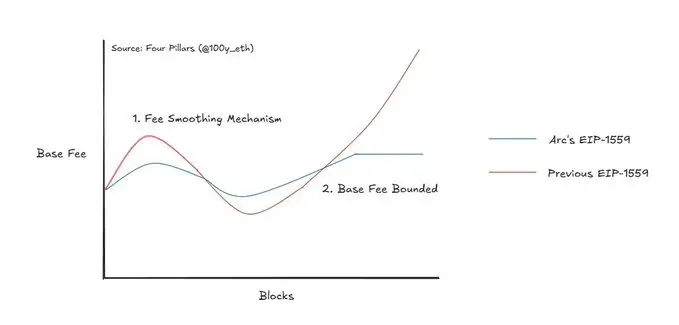
Arc has made several improvements to the EIP-1559 model. The first is the introduction of a "fee smoothing mechanism": this mechanism uses an exponentially weighted moving average algorithm to determine the fees for subsequent blocks by comprehensively considering past and recent block fee data (with older data weights decreasing exponentially and recent data weights increasing). Traditional EIP-1559 only references the usage of the previous block to determine the base fee for the next block, while Arc's improved version significantly smooths the volatility of the base fee by incorporating usage data from multiple historical blocks, including the previous block. The second improvement is the "base fee cap mechanism," which sets a fixed upper limit on the base fee, ensuring that even during periods of congestion on the Arc network, fees do not increase without limit.
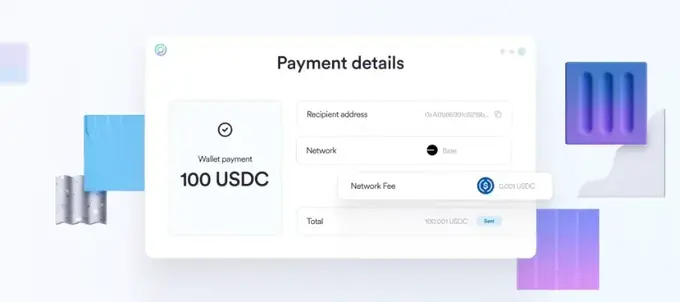
Circle Paymaster, Source: Circle
Arc not only supports USDC but also allows various stable-value tokens to be used as fee tokens, including stablecoins pegged to other national currencies, deposit tokens, and central bank digital currencies. This feature is associated with Circle's payment custody service.
Circle Paymaster was initially a feature based on the ERC-4337 standard, allowing users to pay transaction fees using USDC on other EVM blockchains without using the native token of that chain. However, since Arc defaults to using USDC as the fee token, utilizing this payment master feature allows for transaction fees to be paid with tokens other than USDC.
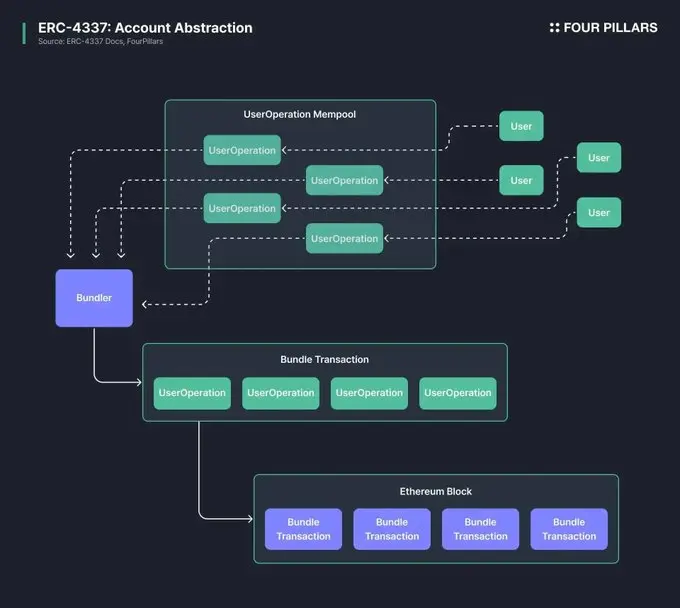
The ERC-4337 standard is currently the most widely used account abstraction protocol, which adds Entrypoint, Bundler, and Paymaster functional modules without changing the underlying Ethereum protocol, significantly lowering the implementation threshold for account abstraction. In this protocol, users no longer directly sign transactions but instead sign independent objects called UserOps. These UserOps are stored in a separate off-chain memory pool rather than the official Ethereum memory pool. The Bundler verifies these UserOps and packages them into a single bundled transaction, which is then sent to a smart contract called Entrypoint. The entry contract completes the verification execution and Gas fee settlement for all UserOps at once, at which point the Paymaster module allows users to pay Gas fees with other tokens.
As we can see, Arc's fee model allows enterprise users to avoid holding highly volatile tokens like ETH or SOL to pay transaction fees, while significantly reducing the volatility of transaction fees. This not only enhances business predictability but also greatly simplifies the financial accounting process for enterprises.
In the early stages of Arc's development, the fees collected will be injected into the Arc on-chain treasury to support the long-term development of the network.
2.3 Deterministic Instant Finality Supported by Malachite
For a blockchain network to become a financial system in the real world, it must meet two main conditions: first, high scalability to handle a large number of transactions, and second, deterministic instant transaction finality that does not rely on probability. To achieve this goal, Arc has brought in developers from Informal Systems and adopted the Malachite consensus algorithm.
Informal Systems is a Canadian infrastructure company that has long been deeply involved in the construction of the Cosmos ecosystem, leading protocol design and development work. Notably, the co-founder team of this company previously worked at Tendermint and the Interchain Foundation, so they have a deep accumulation in the technical field based on the Tendermint BFT consensus protocol. In short, Informal Systems is the core team that continues the Tendermint technology and is currently promoting the development of its successor, CometBFT.
Malachite is a high-performance BFT consensus engine developed by Informal Systems based on the Rust language. The Malachite team from Informal Systems has joined Circle to jointly build the core consensus algorithm supporting the Arc project.
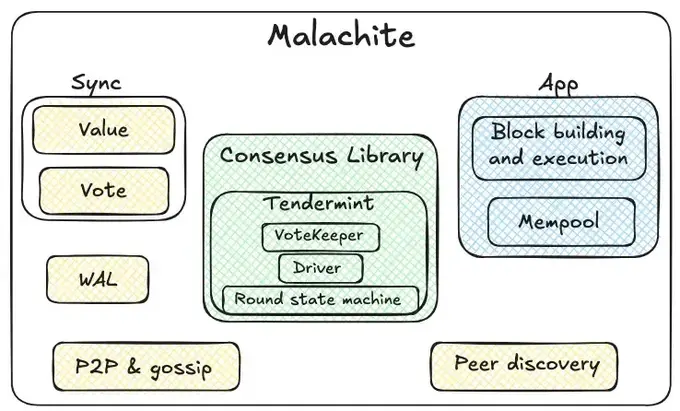
Source: Informal Systems
Compared to the existing CometBFT, Malachite achieves modular simplification by removing unnecessary components and streamlining the core. As a result, the core library of Malachite ultimately consists of three modules.
- Vote Keeper: Collects votes from network participants and tracks quorum progress.
- Round State Machine: Implements the core logic of Tendermint voting rounds.
- Driver: Operates the state machine across multiple rounds.
Since this library makes no assumptions about the execution environment and does not limit the types of applications connected, its advantage lies in providing a highly generic consensus API interface.
Malachite not only provides a simple consensus library but also offers an engine that allows developers to easily build production nodes. This technology also includes the following features:
- Synchronization: Synchronization of block proposals and voting data during the consensus process.
- Pre-write logs: Fault recovery and data integrity assurance.
- P2P & Gossip communication: Propagation of blocks, transactions, and voting messages between nodes.
- Node discovery: Finding other nodes in the network.
- Functional modules: Block creation and execution logic, as well as transaction memory pool.
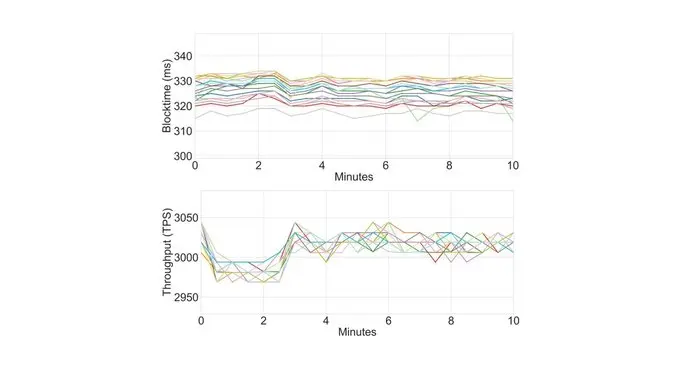
Source: Arc
Thanks to the Rust-based implementation mechanism and streamlined modular design, Malachite has demonstrated outstanding performance in benchmark tests, laying the foundation for Arc's scalability. In tests with 20 geographically distributed validator nodes, Arc achieved a transaction processing capacity of 3,000 transactions per second and reached finality within 350 milliseconds. Additionally, because the core of Malachite adopts the Tendermint BFT consensus mechanism, the system can provide guarantees of instant finality.
2.4 Optional Privacy Solutions for Sensitive Information Protection and Regulatory Compliance
A privacy feature that protects users' sensitive transaction information while allowing regulators to view account transaction information when necessary is an indispensable part of real-world financial infrastructure. To achieve this goal, Arc plans to introduce optional privacy protection features in upgrades after the mainnet launch.
In the early privacy roadmap, Arc will launch a "confidential transfer" feature. This feature will hide transaction amounts while making addresses public, allowing regulatory agencies and analytical tools to track transactions, with the goal of maintaining compatibility with existing blockchain analysis and monitoring systems. Notably, by introducing "view keys," this mechanism allows approved third parties, such as auditors and regulators, to gain read-only access to specific transaction data, ensuring compliance. For institutions, this technology enables them to have a comprehensive understanding of all transaction details of their clients, thereby meeting regulatory requirements such as transaction monitoring and the "Funds Transfer Rules."
To achieve this goal, Arc will provide an EVM precompiled contract that allows smart contracts to interact with a cryptographic backend. This backend will initially adopt trusted execution environment (TEE) technology to enable fast and verifiable privacy transactions, which significantly distinguishes it from many existing privacy solutions. In the future, Arc plans to integrate multiple cryptographic technologies beyond TEE, including zero-knowledge proofs, fully homomorphic encryption, and secure multi-party computation.
In the future privacy technology roadmap, Arc plans to go beyond simple encrypted transaction functions and upgrade to support "privacy states" and "confidential computing" technologies, thereby supporting advanced privacy application scenarios, such as:
- Privacy order books: Maintaining order book status in exchanges without external disclosure.
- Financial transaction agreements: Keeping the terms of trading agreements confidential.
- Automated fund management: Keeping corporate fund management logic confidential.
3. Similar Yet Different Script with Tether
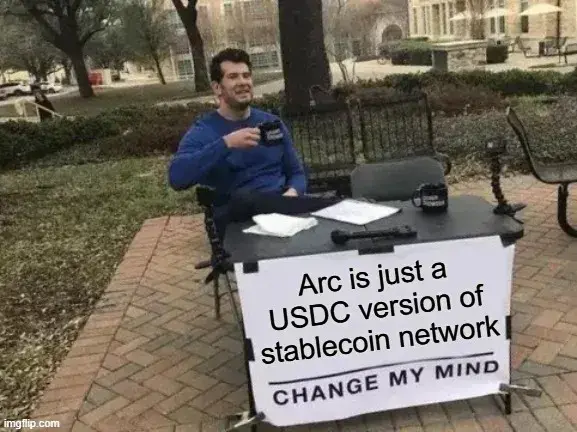
The Arc solution launched by Circle is very similar yet somewhat different from the USDT-focused networks supported by Tether (such as Stable and Plasma).
3.1 Similar Script
3.1.1 Focus on Stablecoin Features
Stable and Plasma are blockchain networks designed specifically for USDT, with core features including: supporting the use of USDT as the default GAS token, achieving high scalability through underlying optimizations, and planning to provide optional privacy protection features. Additionally, these networks implement a zero-fee policy for simple USDT transfer transactions.
For readers familiar with Stable and Plasma, upon first glance at Circle's Arc protocol, one might immediately think, "Wait, isn't this just applying the functions of Stable or Plasma to USDC?" This thought arises because Arc's three core functions: 1) using USDC as the fee token, 2) optional privacy protection, and 3) high scalability, are almost indistinguishable from the key features of the former two.
The key difference here is that Circle's Arc chain only supports the use of USDC as the payment fee token and does not offer a zero-fee policy for USDC transfer transactions.
3.1.2 Privacy Still Takes a Backseat
It is worth noting that, in addition to Circle's Arc chain, Stable and Plasma also plan to provide optional privacy features for user data protection and regulatory compliance. However, these features are still in active development and will not be supported at the time of the initial mainnet launch. This is primarily due to the complex technical challenges associated with immediately introducing privacy features. It remains uncertain which stablecoin network will be the first to implement optional privacy features, and even after such features are realized, the actual user experience from the perspectives of users, enterprises, and regulatory agencies remains to be seen.
3.2 Arc's Own Script
Upon closer inspection, Arc may seem like just another stablecoin network supporting USDC, but it actually possesses a unique design that distinguishes it from existing stablecoin networks.
3.2.1 Integration with Circle's Product Line
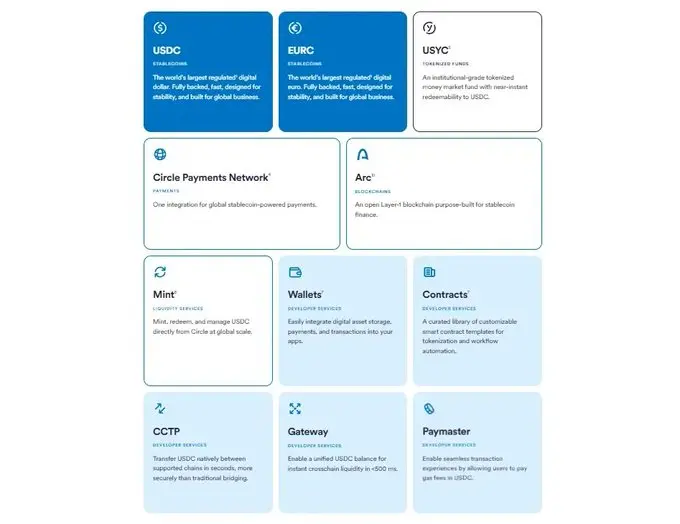
Source: Circle
Compared to other stablecoin networks, Arc's greatest advantage lies in its ability to flexibly integrate with other services provided by Circle. Among many stablecoin issuers, Circle is known for its vertically integrated comprehensive stablecoin-related services. By integrating with the following functionalities, Arc can provide a significantly optimized user experience for USDC and EURC holders:
- USYC: A token for an institutional-grade money market fund backed by U.S. short-term Treasury bills. The USYC token will be supported on the first day of the Arc platform launch, allowing users to not only stake USYC but also earn yields from various institutional-grade yield-bearing tokens on the Arc platform.
- Circle Payment Network: A global payment system based on stablecoins and blockchain technology, which can be simply understood as a Web3 version of the SWIFT system. After the official launch of the Arc network, institutions connected to the CPN network will be able to complete stablecoin transaction settlements on this platform.
- Circle Mint: This platform allows USDC and EURC issuers to easily mint and redeem stablecoins. In the future, users will be able to mint and redeem USDC and EURC directly through the Circle Mint feature on the Arc platform in the fastest and most efficient manner.
- Circle Wallet: An infrastructure that enables enterprises to easily integrate Web3 wallets into their products, with assets based on the Arc chain also included in the integration scope.
- Circle Contracts: A platform for deploying, managing, and monitoring various smart contracts based on stablecoin services. Since Arc is an EVM-compatible network, this functionality can be immediately utilized for practical applications.
- CCTP: A cross-chain transfer protocol that serves as a connecting infrastructure, supporting users in conveniently transferring USDC and EURC across multiple networks. Arc will be able to interact with dozens of blockchain networks and facilitate fund transfers through CCTP. With Arc's sub-second transaction confirmation feature, the speed of cross-chain transfers to other networks will be significantly enhanced.
- Circle Paymaster: As previously discussed, this feature allows users to pay transaction fees using tokens other than USDC or to use the fuel fee sponsorship feature on Arc.
3.2.2 Regulatory-Friendly Solutions
Unlike USDT, Circle's USDC not only complies with the U.S. GENIUS Act but also primarily targets the U.S. market. More importantly, a careful reading of Arc's streamlined technical white paper reveals that Circle has placed a high emphasis on regulatory factors when constructing Arc.
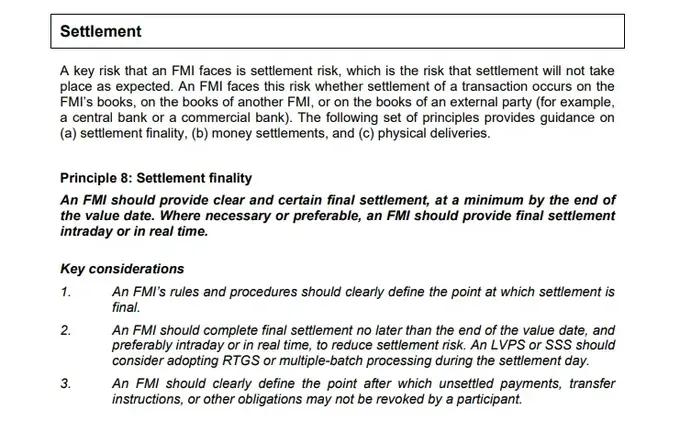
Source: BIS
For example, the Arc technical white paper cites a report from the Bank for International Settlements (BIS) twice.
The first citation emphasizes that all transactions on Arc have instant finality, which aligns with Principle 8: Settlement Finality from the BIS's "Principles for Financial Market Infrastructures" published in 2012.
The second citation points out that Arc's permissioned validator set may have advantages under the "Basel Committee on Banking Supervision's Framework for the Prudential Treatment of Crypto-Asset Risks" published by the BIS in 2022.
Thus, it is evident that the design intent of Arc is not only to serve as a Web3 network for USDC, but many of its regulatory elements have been thoughtfully considered.
3.2.3 Built-in Foreign Exchange Engine
Arc's technical roadmap plans to directly integrate an institutional-grade foreign exchange engine into its network. This foreign exchange engine will support efficient and secure foreign exchange settlements between trading parties across different countries around the clock.
In addition to smart contract-based transactions, the system will also integrate an off-chain Request for Quote (RFQ) mechanism, allowing institutional investors to obtain foreign exchange quotes from market makers, compare prices, and execute trades quickly. This foreign exchange engine can support a variety of foreign exchange-related services, including cross-border payments, foreign exchange hedging, automated fiat/cryptocurrency exchange channels, and stablecoin futures markets.
4. Final Thoughts
The divergence in stablecoin network strategies between Tether and Circle has become apparent: Tether chooses to support external projects like Stable and Plasma to build a dedicated USDT network, while Circle is committed to creating its own USDT ecosystem. Both paths have their pros and cons; Tether's model allows for rapid ecological expansion focused on USDT, avoiding excessive constraints from Tether's corporate governance, but it is difficult to fully align with Tether's strategy, which may lead to ecological fragmentation. In contrast, Circle can provide a more complete user experience through highly integrated products, but the speed of Arc's ecological development may be limited due to strict adherence to corporate governance and compliance requirements. The success or failure of these two models will ultimately be determined by time and the market.
Will the competition between Circle and Tether intensify? Some may view Circle's launch of a new public chain focused on USDC as a signal of escalating competition between Circle and Tether. While this is a reasonable argument, it is somewhat overly simplistic. The significance of Arc's launch lies more in seamlessly connecting and enhancing Circle's existing product portfolio rather than entering a completely new ecosystem. The competition between Circle and Tether has already been fierce, and the launch of Arc is not expected to significantly deepen this competition. Arc's true competitors may be closer to Stripe's Tempo rather than the Stable or Plasma platforms.
What is the future direction of Codex and 1Money Network? Before Circle announced the launch of the Arc network, there was a lack of dedicated stablecoin networks issuing USDC independently, which garnered significant attention for Codex and 1Money Network. Among these two blockchain projects focused on stablecoins, Codex received strategic investment from Circle Ventures and supports native USDC issuance, while 1Money Network is a Circle Alliance partner utilizing the Circle Mint feature. However, with Circle's official entry, these projects may find themselves at a disadvantage in terms of market attention within the crypto community, and it remains unclear what market entry strategies they will adopt moving forward.
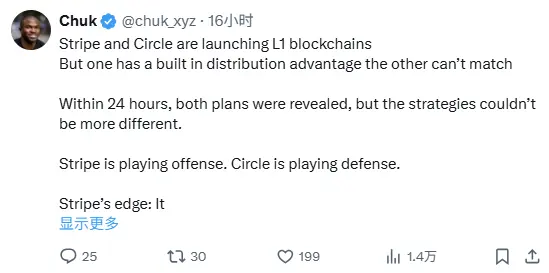
- Is Arc's competitor Tempo? Chuk from Paxos provided an interesting perspective that I would like to share here. His tweet compared Circle's Arc with Stripe's Tempo, pointing out that the two adopt completely different strategies and positions, with Stripe being offensive and Circle being defensive. These differences increase the likelihood of their respective successes.
免责声明:本文章仅代表作者个人观点,不代表本平台的立场和观点。本文章仅供信息分享,不构成对任何人的任何投资建议。用户与作者之间的任何争议,与本平台无关。如网页中刊载的文章或图片涉及侵权,请提供相关的权利证明和身份证明发送邮件到support@aicoin.com,本平台相关工作人员将会进行核查。




